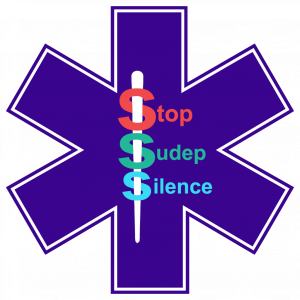
Campaigning to stop the silence around
Sudden Unexpected Death in Epilepsy
#DoNoHarm
On the 3rd of May 2019 our son Peter tragically died at home, suddenly and unexpectedly. The death was recorded as SUDEP (Sudden Unexpected Death in Epilepsy). My husband and I were to suffer the acute trauma of discovering our child’s lifeless body in his room at home and the continuing trauma of a life without him.
No one in Peter’s epilepsy care team ever had a conversation with us about SUDEP or that he was becoming increasingly at risk. We are also discovering the distressing and painful fact, that this is the case for many other young men and women with epilepsy who have sadly died.
The ‘Stop SUDEP Silence’ campaign aims are to create a movement to embed the message that although ‘considered’ rare, Sudden Unexpected Death in Epilepsy is a very real risk. That clinicians must inform patients and care givers of SUDEP at time of diagnosis or soon after as the NICE guideline dictates. This will hopefully avoid future unnecessary deaths like Peter’s.
According to Epilepsy Research UK, there are 21 epilepsy related deaths every week (3 per day) in the UK, with mortality attributed to epilepsy increasing even though overall U.K. mortality is decreasing [1]. Annual epilepsy deaths match those for asthma though the prevalence of asthma is ten times that of epilepsy [2]. Data suggests that SUDEP deserves the same attention as other life-threatening events, such as SIDS (Sudden Infant Death Syndrome) or sudden death associated with heart disease [3].
Sudden Unexpected Death in Epilepsy (SUDEP) is the leading cause of epilepsy-related deaths with an annual incidence of 1 per 1000 adult and 1 per 4500 paediatric patients [4]. The SUDEP rate in people with very frequent seizures has been estimated to be between 1 in 50 and 1 in 100. Although SUDEP is more common in people with frequent seizures it has also occurred in people who have had very few seizures. The risk increases if you have generalised tonic-clonic seizures (GTCS), especially if they happen at night or when asleep [5].
It is estimated that approximately half of epilepsy related deaths were identified to be potentially avoidable had Persons With Epilepsy (PWE) and/or their families been more aware of the risks of morbidity and mortality [2], yet still only a minority of clinicians openly discuss SUDEP with patients. Reported rates may be an underestimate because of poor case identification due to lack of awareness and inconsistencies in the investigation and recording of the deaths [3].
Chronic underinvestment in research into epilepsy has meant effective treatments for everyone living with the condition are still decades away. However despite being one of the most common, serious neurological conditions, just 0.3% of the £4.8bn spent on health-related research in 2018 was invested in epilepsy [7].
SUDEP was defined for the first time by Dr Lina Nashef in 1997, ironically the year Peter was born, yet despite the National Institute for Health and Care Excellence (NICE) guidelines clear recommendation that epilepsy risks and SUDEP are discussed, persons with epilepsy and their families are continuing to report poverty of and inconsistent information about risk [2] well into its third decade.
Research repeatedly shows that patients and families want to be told about SUDEP and of the risk factors and risk-reduction measures that can be taken. However, there does not appear to be consensus from healthcare professionals on whether all patients, or only selected patients (e.g. those with uncontrolled seizures), should be informed about the risk of SUDEP [8]. Being informed allows for the positive steps that can be taken.
The recurrent theme among research shows that the main reason for not informing of SUDEP is due to the clinician’s anxiety even though most patients agreed that SUDEP awareness motivated them to better manage factors that trigger seizures, better management of the disease and better therapy adherence [9]. Additionally this allows for caregivers to taking precautionary measures. Clinicians appear to anticipate that patients will be anxious or distressed discussing SUDEP but contrary to the expectations, being informed on SUDEP risk does not have adverse effects on quality of life or mood itself, according to studies. Negative reactions to SUDEP discussions are common, however, they do not have long term effects, and proper communication skills combined with experience can minimize them [4].
While clinicians continue to prioritise their own anxiety and discomfort around SUDEP conversations or to cite ‘a patients ‘right not to know’ or ‘do no harm’, preventable deaths will continue to happen.
There have been other campaigns to highlight the plight of SUDEP to educate, inform and encourage clinicians to have clear and specific discussions with patients but it is still not happening. Many more thousands of lives, mostly in the young, continue to be lost leaving families in the worst imaginable pain.
The fact that a clinician makes the decision alone not to have these preventative, safeguarding discussions only serves to add to a parents anguish and while ever there continues to be no direct upholding of accountability for clinicians decision not to inform, this is going to continue to happen. We will be no further forward another three decades from now.

The Peter Doody Foundation’s ‘Stop Sudep Silence’ campaign #DoNoHarm is calling for the following to prevent any more preventable deaths:
1. Inform people living with epilepsy about SUDEP in its entirety to ensure they fully understand. To not avoid using the word SUDEP, and what that means by only talking of generic risk. Patients should be informed of all mechanisms of SUDEP including heart and respiratory failure.
For example, In Peters’ medical records, a covering letter to his doctor with an accompanying checklist, shows the SUDEP box as being ticked. We know it wasn’t discussed because we were there.
2. A Comprehensive Person Centred Care Plan (CCP), as recommended in NICE guidlines, with clear set pathways. A copy of the CCP, regularly updated at each appointment and a copy given to the patient.
3. The option to share the CCP with members of the patients care team and encouragement for parents/carers to attend appointments to avoid assumptions that because the person living with epilepsy is of adult age they want to have lone responsibility of their care.
Peter wasn’t seen by a consultant once in three years. We were told ‘he slipped through the net’. Had a Comprehensive Person Centred Care Plan been in place this would have been picked up.
4. Accountability with a recorded account of what information relating to SUDEP was specifically given to the patient and countersigned. A recorded account at each appointment of the reasons a clinician continues to decide not to inform of SUDEP. This decision to be made available to bereaved families and interested parties to stand up to scrutiny following a SUDEP outcome.
5. Further exploration into an epilepsy patient’s condition. As increased risk factors become apparent, routine admittance overnight for monitoring and further assessment in specialist epilepsy clinics. This would be an additional therapeutic aid in the detection of nocturnal seizures and of any other co-morbidities.
6. Routine blood tests to identify non adherence to anti-seizure medication.
7. Inform of the varying aids available with accompanying written details as an additional aid in detecting un witnessed seizures to assist with additional safe guarding measures.
If we continue to not have these conversations, if the Epilepsy Specialist Nurse, Doctor or Consultant don’t want to or feel unable to discuss in definitive terms about SUDEP, then lives will continue to be needlessly lost.
That sadly, two decades on from the NICE guidelines being in place and epilepsy deaths rates increasing we will learn of more and more parents and families going through anguish of trying to come to terms with the death of their child or loved one.
Please allow people with epilepsy their right to live longer and for parents to love their sons and daughters longer. No parent should have to bury or cremate their child in such circumstances where their right as parents were taken away from them to safeguard THEIR child and the potential to keep their child alive.
A CONVERSATION ABOUT ‘RISKS’ IS NOT A CONVERSATION ABOUT ‘SUDEP’ UNLESS SUDEP IS SPECIFICALLY REFERRED TO.
#DoNoHarm
